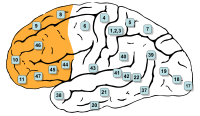
Photo from wikipedia
Persistent activity of cue-representing neurons in the prefrontal cortex (PFC) is regarded as a neural basis for working memory. The contribution of short-term synaptic plasticity (STP) at different types of… Click to show full abstract
Persistent activity of cue-representing neurons in the prefrontal cortex (PFC) is regarded as a neural basis for working memory. The contribution of short-term synaptic plasticity (STP) at different types of synapses comprising the cortical network to persistent activity, however, remains unclear. Characterizing STP at synapses of the rat PFC layer 5 network, we found that PFC synapses exhibit distinct STP patterns according to presynaptic and postsynaptic identities. Excitatory postsynaptic currents (EPSCs) from corticopontine (Cpn) neurons were well sustained throughout continued activity, with stronger depression at synapses onto fast-spiking interneurons than those onto pyramidal cells. Inhibitory postsynaptic currents (IPSCs) were sustained at a weaker level compared with EPSC from Cpn synapses. Computational modeling of a balanced network incorporating empirically observed STP revealed that little depression at recurrent excitatory synapses, combined with stronger depression at other synapses, could provide the PFC with a unique synaptic mechanism for the generation and maintenance of persistent activity.
Journal Title: Cerebral cortex
Year Published: 2019
Link to full text (if available)
Share on Social Media: Sign Up to like & get
recommendations!